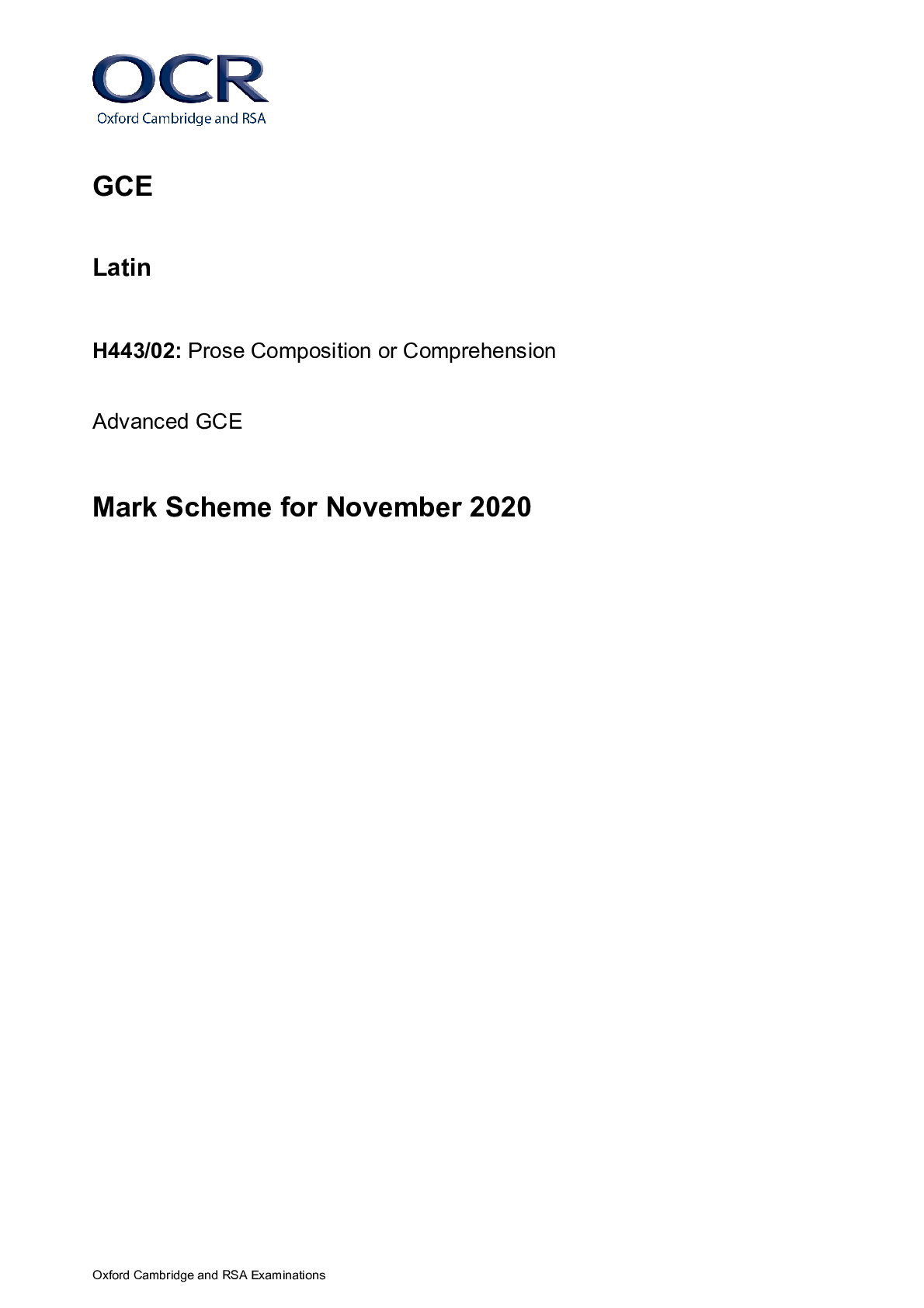Economics > GCSE MARK SCHEME > GCSE (9–1) Economics J205/01: Introduction to economics General Certificate of Secondary Education (All)
GCSE (9–1) Economics J205/01: Introduction to economics General Certificate of Secondary Education Mark Scheme for November 2020
Document Content and Description Below
GCSE (9–1) Economics J205/01: Introduction to economics General Certificate of Secondary Education Mark Scheme for November 2020 Oxford Cambridge and RSA Examinations GCSE (9–1) Economics... J205/01: Introduction to economics General Certificate of Secondary Education Mark Scheme for November 2020Oxford Cambridge and RSA Examinations OCR (Oxford Cambridge and RSA) is a leading UK awarding body, providing a wide range of qualifications to meet the needs of candidates of all ages and abilities. OCR qualifications include AS/A Levels, Diplomas, GCSEs, Cambridge Nationals, Cambridge Technicals, Functional Skills, Key Skills, Entry Level qualifications, NVQs and vocational qualifications in areas such as IT, business, languages, teaching/training, administration and secretarial skills. It is also responsible for developing new specifications to meet national requirements and the needs of students and teachers. OCR is a not-for-profit organisation; any surplus made is invested back into the establishment to help towards the development of qualifications and support, which keep pace with the changing needs of today’s society. This mark scheme is published as an aid to teachers and students, to indicate the requirements of the examination. It shows the basis on which marks were awarded by examiners. It does not indicate the details of the discussions which took place at an examiners’ meeting before marking commenced. All examiners are instructed that alternative correct answers and unexpected approaches in candidates’ scripts must be given marks that fairly reflect the relevant knowledge and skills demonstrated. Mark schemes should be read in conjunction with the published question papers and the report on the examination. © OCR 2020J205/01 Mark Scheme November 2020 2 Annotations Annotation Meaning Tick Cross Unclear Analysis Application Benefit of the doubt BP Blank page Evaluation Knowledge Level one Level two Level three Not answered question Noted but no credit given. Off page comment Own figure rule Too vagueJ205/01 Mark Scheme November 2020 3 Highlighting is also available to highlight any particular points on the script. BP to be inserted on every blank page ‘SEEN’ to be inserted in every question space where NR is the mark.J205/01 Mark Scheme November 2020 4 12. Subject Specific Marking Instructions Levels of response / Level descriptors Knowledge and understanding Application Analysis Evaluation Good Good knowledge and understanding of the theory stated or referred to in the question. All of the terms/theoretical concepts are explicitly or implicitly understood. Good application of knowledge to a given scenario. The terms/theoretical concepts are used/adapted/changed in the context of the given scenario. There is good understanding of all the relevant elements of the scenario. Good analysis of the effect of xxxx. There is correct analysis in the form of developed links. These links are developed through a chain of reasoning which addresses the question. Any relevant diagram(s) are predominantly correct and linked to the analysis. Good evaluation with a fully supported judgement that is developed from a weighing up arguments/both sides/comparing alternatives. Reasonable Reasonable knowledge and understanding of the theory stated or referred to in the question. Most of the terms/theoretical concepts are explicitly or implicitly understood. Reasonable application of knowledge to a given scenario. The terms/theoretical concepts are used/adapted/changed in the context of the given scenario. There is understanding of some the relevant elements of the scenario. Reasonable analysis of the effect on xxxx. There is correct analysis largely in the form of single effects. These address the question but are not developed into a clear chain of reasoning. The relevant diagram(s), if present, may be improperly labelled or not linked to the analysis. Reasonable evaluation of xxx considering arguments/both sides/comparing alternatives. There may be a judgement but this will not be fully supported. Limited Limited knowledge and understanding of the theory stated or referred to in the question. Some of the terms/theoretical concepts are explicitly or implicitly understood. Limited application of knowledge to a given scenario. There is an attempt to use/adapt/change the terms/theoretical concepts in the context. Limited analysis of the effect on xxxx. There is an attempt at analysis which may include a single effect that has some link to the question. Diagrams (if present) are unlikely to be correct and not linked to the analysis. Limited evaluation of xxx that may include an incomplete consideration of arguments/both sides/comparing alternatives with unsupported statements.J205/01 Mark Scheme November 2020 5 Section A Question Key AO Quantitative skills 1 A 1a 2 B 1b 3 A 1b 4 C 2 Yes 5 D 1a 6 C 2 Yes 7 B 1b 8 B 1b 9 C 1a 10 B 1b 11 B 2 12 B 1b 13 A 1b 14 A 2 15 C 2 Yes 16 C 1b 17 A 1b 18 B 2 19 D 2 Yes 20 C 1bJ205/01 Mark Scheme November 2020 6 Section B Question Answer Mark Guidance 21 (a) State what is meant by ‘the equilibrium price and quantity’. Answers may include: • Where the quantity demanded exactly matches (is equal to) the quantity supplied • Where there is no pressure for price or quantity to change • Where the market clears ARA 2 AO1a Give 2 marks for a precise answer, as shown. Give 1 mark for a less precise answer such as: • ‘where supply and demand cross/meet’ • ‘where price stays the same’ • ‘where quantity stays the same’ 21 (b) Draw a diagram showing equilibrium price and quantity. P S p D 0 q Q 2 AO1b Give 2 marks for a clear diagram showing a supply and demand curve with an equilibrium point indicated (in some way) where the two lines cross Give 1 mark for a correct diagram with no equilibrium indicated No reward for a diagram which confuses supply and demand curves OR does not label both of them.J205/01 Mark Scheme November 2020 7 Question Answer Mark Guidance 21 (c) Using a diagram, analyse the consequences of a movement along the demand curve for Plumwith Holidays. Answers may include: • An increase in supply is a movement along the demand curve • An increase in supply will lead to a fall in price, but an increase in quantity demanded • Change in quantity demanded will move in the opposite direction to price. • If demand is price elastic the increase in supply will lead to a larger rise in demand than the fall in price increasing revenue and possibly profits. • Consumers will be able to afford more/longer holidays P S p S1 p1 D 0 q q1 Q 6 1xAO1a 2xAO2 3xAO3a All level descriptors describe the TOP of the level – please read guidance at the beginning of the mark scheme regarding best fit approach. Level 3 (5-6 marks) (AO1a – 1 mark, AO2 – 2 marks, AO3a – 3 marks = 6 marks) Reasonable knowledge and understanding. All of the terms/theoretical concepts are explicitly or implicitly understood. Reasonable application of the likely impact of an increase in supply on price, quantity and revenue/profits. The terms/theoretical concepts are used/adapted/changed in the context of the given scenario. There is understanding of some of the relevant elements of the scenario. Good analysis of the likely impact of an increase in supply on price, quantity and revenue/profits. There is correct analysis in the form of developed links. These links are developed through a chain of reasoning which addresses the question. The diagram is predominantly correct and linked to the analysis. Level 2 (3-4 marks) (AO1a – 1 mark, AO2 – 1 mark, AO3a – 2 marks = 4 marks) Reasonable knowledge and understanding. Most of the terms/theoretical concepts are explicitly or implicitly understood. Limited application of knowledge to the likely impact of an increase in supply on price, quantity and revenue/profits. There is an attempt to use/adapt/change the terms/theoretical concepts in the context. Reasonable analysis of the likely impact of an increase in supply on price, quantity and revenue/profits. There is correct analysis, largely in the form of single effects. These address the question but are not developed into a clear chain of reasoning. The relevant diagram(s), if present, may be improperly labelled or not linked to the analysis. Level 1 (1-2 marks) (AO1a – 1 mark, AO2 – 0 marks, AO3a – 1 mark = 2 marks)J205/01 Mark Scheme November 2020 8 Question Answer Mark Guidance NB: A maximum of 4 marks if there is no correct diagram or no reference made to the diagram in part b. ARA Reasonable knowledge and understanding. Some of the terms/theoretical concepts are explicitly or implicitly understood. No application of knowledge to the likely impact of an increase in supply on price, quantity and revenue/profits. There is an attempt to use/adapt/change the terms/theoretical concepts in the context. Limited analysis of the likely impact of an increase in supply on price, quantity and revenue/profits. There is an attempt at analysis which may include a single effect that has some link to the question. Diagrams (if present) are unlikely to be correct and not linked to the analysis. 0 marks No response or no work worthy of credit. N.B. Any other relevant points and/or evidence of learners’ understanding of the connections between the various topics of both components to be credited. 21 (d) (i) Explain how Plumwith Holidays acts as a producer of services. Answers may include: • Acts as the supplier of holidays • May ‘tailor’ products to specific needs of customers • Is able to influence price • Brings together factors of production (land, the building; capital, money they have invested in the firm; labour, themselves; enterprise, setting up) ARA 2 AO2 Give 2 marks for an answer that shows clear understanding of the term in relation to the holiday industry Give 1 mark for a less clear answer. Any answer MUST be in the context of a business in the holiday industry 21 (d) (ii) Calculate the average cost to Plumwith Holidays of providing eight holidays. You must show your working. £28 000 = £3 500 8 2 AO2 1 mark for correct working. 1 mark for correct answer including £ sign. Award 2 marks for an answer of £3,500J205/01 Mark Scheme November 2020 9 Question Answer Mark Guidance 21 (d) (iii)* Evaluate the importance of cost and revenue data for the owners of Plumwith Holidays. Use the information given in Extract 1 on page 9 and your own knowledge. Importance of cost may include: • Can determine if a firm makes a loss or a profit: cost greater than revenue = loss; cost less than revenue = profit • A fall in costs of running the firm/costs of holidays means more can be supplied • Costs rise as output increases so supply curve slopes upwards Importance of revenue may include: • Low revenue is likely to lead to a loss • Growth in revenue encourages the owners of Plumwith to expand the business • Growth in revenue/steady revenue can make it easier to obtain loans/obtain lower interest on overdraft • Creates confidence in the firm for suppliers of holidays/hotel owners, etc • Makes it easier to supply holidays that the consumer wants Evaluation may include: • By having cost and revenue data, Plumwith Holidays can work out its likely profit or loss. It can also make better forecasts for the future. • The usefulness of the cost and revenue data will be dependent on how accurate and up-to-date it is. As every holiday is likely to be different this may not be easy. 6 1xAO2 2xAO3a 3xAO3b All level descriptors describe the TOP of the level – please read guidance at the beginning of the mark scheme regarding best fit approach. Level 3 (5-6 marks) (AO2 – 1 mark, AO3a – 2 marks, AO3b – 3 marks = 6 marks) Good application of knowledge of the importance of costs and revenue for the producer. The terms/theoretical concepts are used/adapted/changed in the context of the given scenario. There is good understanding of all the relevant elements of the scenario. Reasonable analysis of the effects of costs and revenue for the producer. There is correct analysis, largely in the form of single effects. These address the question but are not developed into a clear chain of reasoning. The relevant diagram(s), if present, may be improperly labelled or not linked to the analysis. Good evaluation of the effects of the importance of costs and revenue for the producer with a fully supported judgement that is developed from a weighing up of arguments/both sides. There is a well-developed and detailed line of reasoning which is coherent and logically structured. The information presented is entirely relevant and substantiated. Level 2 (3-4 marks) (AO2 – 1 mark, AO3a – 1 mark, AO3b – 2 marks = 4 marks) Good application of knowledge of the importance of costs and revenue for the producer. The terms/theoretical concepts are used/adapted/changed in the context of the given scenario. There is good understanding of all the relevant elements of the scenario. Limited analysis of the effects of costs and revenue for the producer. There is an attempt at analysis which may include a single effect that has some link to the question. Diagrams (if present) are unlikely to be correct and not linked to the analysis. Reasonable evaluation of the effects of the importance of costs and revenue for the producer considering arguments/both sides. There may be a judgement but this will not be fully supported.J205/01 Mark Scheme November 2020 10 Question Answer Mark Guidance ARA There is a line of reasoning presented with some structure. The information presented is in the most-part relevant and supported by some evidence. Level 1 (1-2 marks) (AO2 – 0 marks, AO3a – 1 mark, AO3b – 1 mark = 2 marks) No application knowledge of the importance of costs and revenue for the producer. There is an attempt to use/adapt/change the terms/theoretical concepts in the context. Limited analysis of the effects of costs and revenue for the producer. There is an attempt at analysis which may include a single effect that has some link to the question. Diagrams (if present) are unlikely to be correct and not linked to the analysis. Limited evaluation of the importance of costs and revenue for the producer that may include an incomplete consideration of arguments/both sides with unsupported statements. Information presented is basic and may be ambiguous or unstructured. The information is supported by limited evidence. 0 marks No response or no work worthy of credit. N.B. Any other relevant points and/or evidence of learners’ understanding of the connections between the various topics of both components to be credited.J205/01 Mark Scheme November 2020 11 Question Answer Mark Guidance 22 (a) State what is meant by ‘opportunity cost’. Answers may include: • The (cost of the) next best opportunity forgone/given up when making a decision/choice • What is given up when making a decision on the use of scarce resources ARA 2 AO1a Give 2 marks for a clear definition along the lines given. Give 1 mark for an answer which omits ‘next best’ or only gives an example. 22 (b) Explain how the rate of interest payable to Muncaster United varies with the quantity of savings. Answers may include: • The amount saved increases slowly with the rise in interest rate up to £400 000, but then increases more rapidly. ARA 2 AO2 Give 2 marks for a clear explanation of the link as shown with reference to both the rise and increase in the rate of rise – allow reference to £600 000 as well as £400 000 Give 1 mark for an answer which has a basic idea that the relationship is positive: ‘As the rate of interest increases so does the amount saved’ OR ‘As the amount of saving increases so does the rate of interest.’ NB: The question requires specific use of the chart. 22 (c) Analyse how an increase in the rate of interest could affect Arin and Fara’s decision whether to invest in buying new players or to increase the club’s savings for future use. Answers may include: • Increase in the rate of interest encourages higher savings • Reference to the chart in Extract 2 showing this • Depends on the cost of a new player – chart shows that small sums only attract low rates of interest so a cheap player will have a low opportunity cost • Depends on whether new player/s is/are likely to bring about promotion/prevent relegation 6 1xAO1a 2xAO2 3xAO3a All level descriptors describe the TOP of the level – please read guidance at the beginning of the mark scheme regarding best fit approach. Level 3 (5-6 marks) (AO1a – 1 mark, AO2 – 2 marks, AO3a – 3 marks = 6 marks) Reasonable knowledge and understanding. All of the terms/theoretical concepts are explicitly or implicitly understood. Reasonable application of the likely effect of an increase in the rate of interest on the decision. The terms/theoretical concepts are used/adapted/changed in the context of the given scenario. There is understanding of some of the relevant elements of the scenario. Good analysis of the likely effect of an increase in the rate of interest on the decision. There is correct analysis in the form ofJ205/01 Mark Scheme November 2020 12 Question Answer Mark Guidance • The opportunity cost of spending goes up as the rate of interest increases ARA developed links. These links are developed through a chain of reasoning which addresses the question. Any relevant diagram(s) are predominantly correct and linked to the analysis. Level 2 (3-4 marks) (AO1a – 1 mark, AO2 – 1 mark, AO3a – 2 marks = 4 marks) Reasonable knowledge and understanding. Most of the terms/theoretical concepts are explicitly or implicitly understood. Limited application of knowledge of the likely effect of an increase in the rate of interest on the decision. There is an attempt to use/adapt/change the terms/theoretical concepts in the context. Reasonable analysis of the likely effect of an increase in the rate of interest on the decision. There is correct analysis, largely in the form of single effects. These address the question but are not developed into a clear chain of reasoning. Level 1 (1-2 marks) (AO1a – 1 mark, AO2 – 0 marks, AO3a – 1 mark = 2 marks) Reasonable knowledge and understanding. Some of the terms/theoretical concepts are explicitly or implicitly understood. No application of knowledge of the likely effect of an increase in the rate of interest on the decision. There is an attempt to use/adapt/change the terms/theoretical concepts in the context. Limited analysis of the likely effect of an increase in the rate of interest on the decision. There is an attempt at analysis which may include a single effect that has some link to the question. 0 marks No response or no work worthy of credit. N.B. Any other relevant points and/or evidence of learners’ understanding of the connections between the various topics of both components to be credited.J205/01 Mark Scheme November 2020 13 Question Answer Mark Guidance 22 (d) (i) Explain what is meant by ‘an oligopoly’. Answers may include: • A small number of firms control the large majority of market share. • 5 largest firms have more than 50% of the market • Firms able to influence the price and may collude • Barriers to entry will be present • Often leads to non-price competition • Not seen as economically efficient ARA 2 AO1b Give 2 marks for an answer which includes the ideas of small number of large firms controlling the majority of the market. Give 1 mark if there is some idea of the term, e.g. collusion or influence of price/quantity. 22 (d) (ii) Explain one reason why Muncaster United would compete in the market for players. Answers may include: • To achieve objectives which in this case are: o to gain promotion o to gain new supporters • To build a better team/to win matches • To survive/prevent relegation ARA 2 AO2 Give 2 marks for a clear explanation of why Muncaster United would compete in the market. Give 1 mark for a basic statement e.g. ’to gain promotion’. Answers MUST be in the context of a firm in the sports industry.J205/01 Mark Scheme November 2020 14 22 (d) (iii)* Evaluate the economic impact of competition on Muncaster United. Use the information given in Extract 2 on page 13 and your own knowledge. Answers may include: • Find new ways to attract players • Improve existing methods/facilities, etc • Need to seek new sources of finance/investment in the club • Loss of players they want to buy • Loss of revenue as supporters shift allegiance to competitors • Players seek transfers to bigger clubs Evaluation may include: • As we are told this club is only small, any competition from larger clubs may be highly significant and difficult to deal with. • The oligopolistic nature of the market for players may mean that Muncaster United is unable to compete for them which is vital for the team’s success. ARA 6 1xAO2 2xAO3a 3xAO3b All level descriptors describe the TOP of the level – please read guidance at the beginning of the mark scheme regarding best fit approach. Level 3 (5-6 marks) (AO2 – 1 mark, AO3a – 2 marks, AO3b – 3 marks = 6 marks) Good application of knowledge of the likely economic impact of competition. The terms/theoretical concepts are used/adapted/changed in the context of the given scenario. There is good understanding of all the relevant elements of the scenario. Reasonable analysis of the economic impact of competition on Muncaster United. There is correct analysis, largely in the form of single effects. These address the question but are not developed into a clear chain of reasoning. The relevant diagram(s), if present, may be improperly labelled or not linked to the analysis. Good evaluation of the economic impact of competition on Muncaster United with a fully supported judgement that is developed from a weighing up of arguments/both sides/comparing alternatives. There is a well-developed and detailed line of reasoning which is coherent and logically structured. The information presented is entirely relevant and substantiated. Level 2 (3-4 marks) (AO2 – 1 mark, AO3a – 1 mark, AO3b – 2 marks = 4 marks) Good application of knowledge of the likely economic impact of competition. The terms/theoretical concepts are used/adapted/changed in the context of the given scenario. There is good understanding of all the relevant elements of the scenario. Limited analysis of the economic impact of competition on Muncaster United. There is an attempt at analysis which may include a single effect that has some link to the question. Diagrams (if present) are unlikely to be correct and not linked to the analysis. Reasonable evaluation of economic impact of competition on Muncaster United considering arguments/both sides/comparingJ205/01 Mark Scheme November 2020 15 alternatives. There may be a judgement, but this will not be fully supported. There is a line of reasoning presented with some structure. The information presented is in the most-part relevant and supported by some evidence. Level 1 (1-2 marks) (AO2 – 0 marks, AO3a – 1 mark, AO3b – 1 mark = 2 marks) No application of knowledge of the likely economic impact of competition. There is an attempt to use/adapt/change the terms/theoretical concepts in the context. Limited analysis of the economic impact of competition on Muncaster United. There is an attempt at analysis which may include a single effect that has some link to the question. Diagrams (if present) are unlikely to be correct and not linked to the analysis. Limited evaluation of the economic impact of competition on Muncaster United that may include an incomplete consideration of arguments/both sides/comparing alternatives with unsupported statements Information presented is basic and may be ambiguous or unstructured. The information is supported by limited evidence. 0 marks No response or no work worthy of credit. N.B. Any other relevant points and/or evidence of learners’ understanding of the connections between the various topics of both components to be credited.J205/01 Mark Scheme November 2020 16 Question Answer Mark Guidance 23 (a) State what is meant by ‘economies of scale’. Answers may include: • The unit cost advantages a firm can gain (1) by increasing the scale of production (1) • Increase in output (1) leading to a fall in average costs (1) ARA 2 AO1a Give 2 marks for a clear statement along the lines given. Give 1 mark if the general idea is present, but it lacks clarity such as ‘it is the fall in average costs’ NB: Do NOT reward answers which only refer to changes in costs/ total costs 23 (b) Explain one benefit to a firm of choosing to be environmentally sustainable. Answers may include: • Increased sales to environmentally conscious consumers • Increased reputation as being ‘green’ • National recognition • Keeps up with the competition ARA 2 AO1b Give 2 marks for a suitable benefit explained. Give 1 mark if there is a suitable benefit identified, but it lacks valid development. NB: Only reward answers that clearly show a benefit to a firm. 23 (c) Analyse the benefits of specialisation for Calwith Farmers. Answers may include: • Higher output • Increased productivity • Higher quality of goods • Bigger market • Potential economies of scale • Time saving ARA 6 1xAO1a 2xAO2 3xAO3a All level descriptors describe the TOP of the level – please read guidance at the beginning of the mark scheme regarding best fit approach. Level 3 (5-6 marks) (AO1a – 1 mark, AO2 – 2 marks, AO3a – 3 marks = 6 marks) Reasonable knowledge and understanding. All of the terms/theoretical concepts are explicitly or implicitly understood. Reasonable application of knowledge of the benefits of specialisation to Calwith Farmers. The terms/theoretical concepts are used/adapted/changed in the context of the given scenario. There is understanding of some of the relevant elements of the scenario. Good analysis of the benefits of specialisation to Calwith Farmers. There is correct analysis in the form of developed links. These links are developed through a chain of reasoning which addresses theJ205/01 Mark Scheme November 2020 17 Question Answer Mark Guidance question. Any relevant diagram(s) are predominantly correct and linked to the analysis. Level 2 (3-4 marks) (AO1a – 1 mark, AO2 – 1 mark, AO3a – 2 marks = 4 marks) Reasonable knowledge and understanding. Most of the terms/theoretical concepts are explicitly or implicitly understood. Limited application of knowledge of the benefits of specialisation to Calwith Farmers. There is an attempt to use/adapt/change the terms/theoretical concepts in the context. Reasonable analysis of the benefits of specialisation to Calwith Farmers. There is correct analysis, largely in the form of single effects. These address the question but are not developed into a clear chain of reasoning. The relevant diagram(s), if present, may be improperly labelled or not linked to the analysis. Level 1 (1-2 marks) (AO1a – 1 mark, AO2 – 0 marks, AO3a – 1 mark = 2 marks) Reasonable knowledge and understanding. Some of the terms/theoretical concepts are explicitly or implicitly understood. No application of knowledge of the benefits of specialisation to Calwith Farmers. There is an attempt to use/adapt/change the terms/theoretical concepts in the context. Limited analysis of the benefits of specialisation to Calwith Farmers. There is an attempt at analysis which may include a single effect that has some link to the question. Diagrams (if present) are unlikely to be correct and not linked to the analysis or have ignored the Extract. 0 marks No response or no work worthy of credit. N.B. Any other relevant points and/or evidence of learners’ understanding of the connections between the various topics of both components to be credited.J205/01 Mark Scheme November 2020 18 Question Answer Mark Guidance 23 (d) (i) Explain what is meant by ‘the supply of eggs is price elastic’. Answers may include: • Percentage change in quantity supplied of eggs is greater than the percentage change in price • If price rises by 10% quantity supplied of eggs will rise by 15% ARA 2 AO2 Give 2 marks for a clear explanation of price elasticity as applied to egg production/supply Give 1 mark for a basic statement such as, ‘a lot more eggs are supplied as price rises’. Answers MUST be in the context of egg production. 23 (d) (ii) Using the information in Extract 3, draw a supply curve showing the supply of eggs to the farm shop. 2 AO2 Give 2 marks for accurately drawing the supply curve. Maximum 1 mark if the points are not joined up Maximum 1 mark if any one point is incorrect The information in Extract 3 must be used for marks to be gained. 23 (d) (iii)* Evaluate the importance of price elasticity of supply for the consumers of Calwith Farmers’ products. Use the information given in Extract 3 on page 17 and your own knowledge. Answers may include: • As it is price elastic then small changes in demand/price will lead to large changes in quantity of eggs available – so consumers will have ready access to eggs 6 1xAO2 2xAO3a 3xAO3b All level descriptors describe the TOP of the level – please read guidance at the beginning of the mark scheme regarding best fit approach. Level 3 (5-6 marks) (AO2 – 1 mark, AO3a – 2 marks, AO3b – 3 marks = 6 marks) Good application of knowledge of the likely importance of price elasticity of supply for consumers. The terms/theoretical concepts are used/adapted/changed in the context of the given scenario. There is good understanding of all the relevant elements of the scenario. Reasonable analysis of the importance of price elasticity of supply for consumers. There is correct analysis, largely in the form of 0.00 0.50 1.00 1.50 2.00 2.50 3.00 20 30 45 60 85 115J205/01 Mark Scheme November 2020 19 Question Answer Mark Guidance • Although quantity supplied may change considerably, price will be more stable – which will help with consumers’ budgeting in the future • If demand/price falls, it may be more difficult to obtain eggs • Large consumers of eggs (such as producers or supermarkets) know that by offering a higher price they will get a lot more Allow any other valid suggestion including any which consider inelastic supply. Evaluation may include: • The degree of price elasticity will be important. A highly price elastic supply will keep the prices of eggs much more constant. • Other factors may be more important such as the level of demand due to factors such as income or tastes. NB: Answer must refer to consumers (but allow reference to business ‘consumers’). single effects. These address the question but are not developed into a clear chain of reasoning. The relevant diagram(s), if present, may be improperly labelled or not linked to the analysis. Good evaluation of the importance of price elasticity of supply for consumers with a fully supported judgement that is developed from a weighing up of some of the arguments. There is a well-developed and detailed line of reasoning which is coherent and logically structured. The information presented is entirely relevant and substantiated. Level 2 (3-4 marks) (AO2 – 1 mark, AO3a – 1 mark, AO3b – 2 marks = 4 marks) Good application of knowledge of the likely importance of price elasticity of supply for consumers. The terms/theoretical concepts are used/adapted/changed in the context of the given scenario. There is good understanding of all the relevant elements of the scenario. Limited analysis of the importance of price elasticity of supply for consumers. There is an attempt at analysis which may include a single effect that has some link to the question. Diagrams (if present) are unlikely to be correct and not linked to the analysis. Reasonable evaluation of the importance of price elasticity of supply for consumers weighing up some of the arguments. There may be a judgement, but this will not be fully supported. There is a line of reasoning presented with some structure. The information presented is in the most-part relevant and supported by some evidence. Level 1 (1-2 marks) (AO2 – 0 marks, AO3a – 1 mark, AO3b – 1 mark = 2 marks) No application of knowledge of the likely importance of price elasticity of supply for consumers. There is an attempt to use/adapt/change the terms/theoretical concepts in the context.J205/01 Mark Scheme November 2020 20 Question Answer Mark Guidance Limited analysis of the importance of price elasticity of supply for consumers. There is an attempt at analysis which may include a single effect that has some link to the question. Diagrams (if present) are unlikely to be correct and not linked to the analysis. Limited evaluation of the importance of price elasticity of supply for consumers that may include an incomplete consideration of arguments with unsupported statements Information presented is basic and may be ambiguous or unstructured. The information is supported by limited evidence. 0 marks No response or no work worthy of credit. N.B. Any other relevant points and/or evidence of learners’ understanding of the connections between the various topics of both components to be credited.OCR (Oxford Cambridge and RSA Examinations) The Triangle Building Shaftesbury Road Cambridge CB2 8EA [Show More]
Last updated: 2 years ago
Preview 1 out of 22 pages

Buy this document to get the full access instantly
Instant Download Access after purchase
Buy NowInstant download
We Accept:

Reviews( 0 )
$6.00
Can't find what you want? Try our AI powered Search
Document information
Connected school, study & course
About the document
Uploaded On
Oct 07, 2022
Number of pages
22
Written in
Additional information
This document has been written for:
Uploaded
Oct 07, 2022
Downloads
0
Views
87

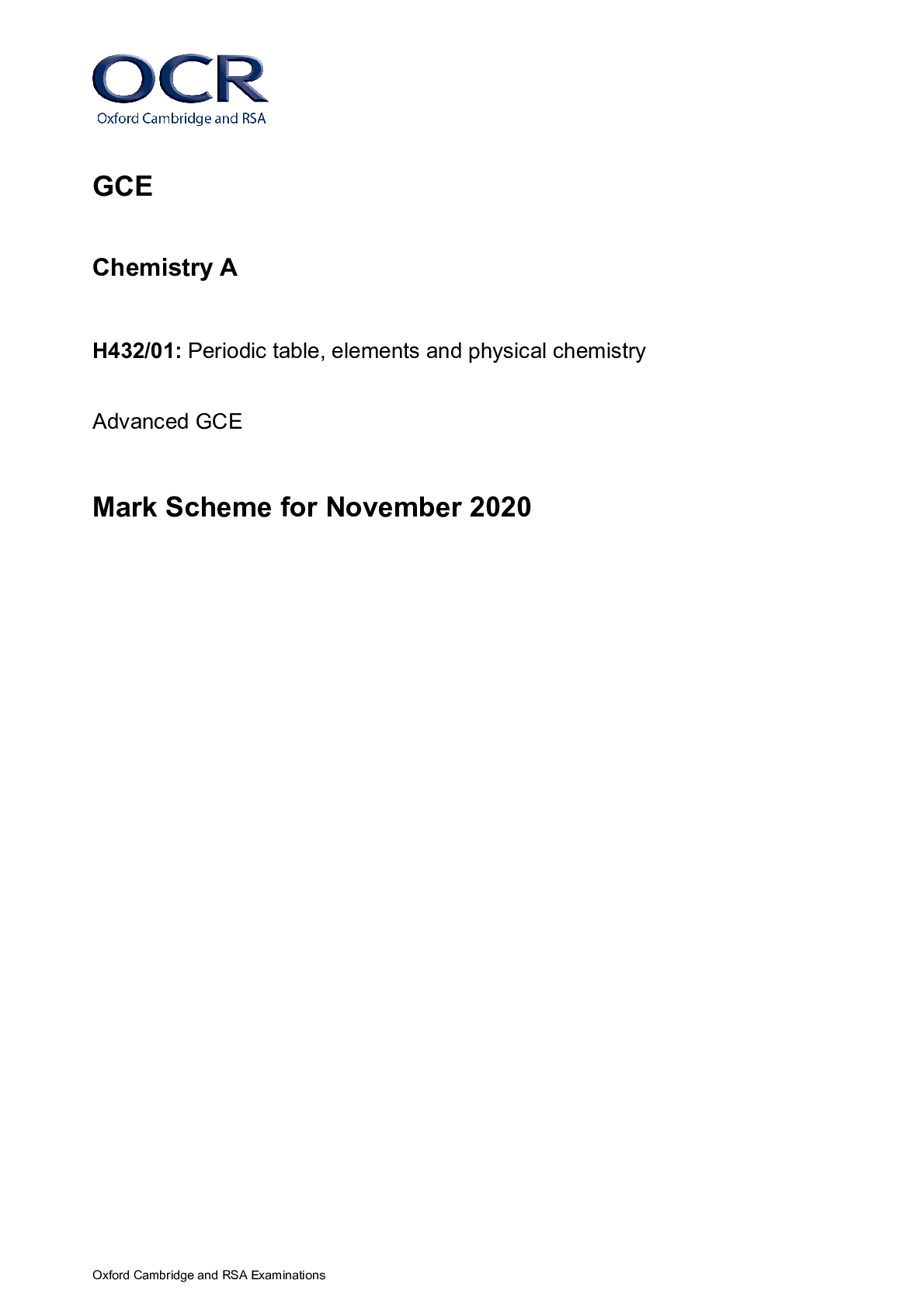
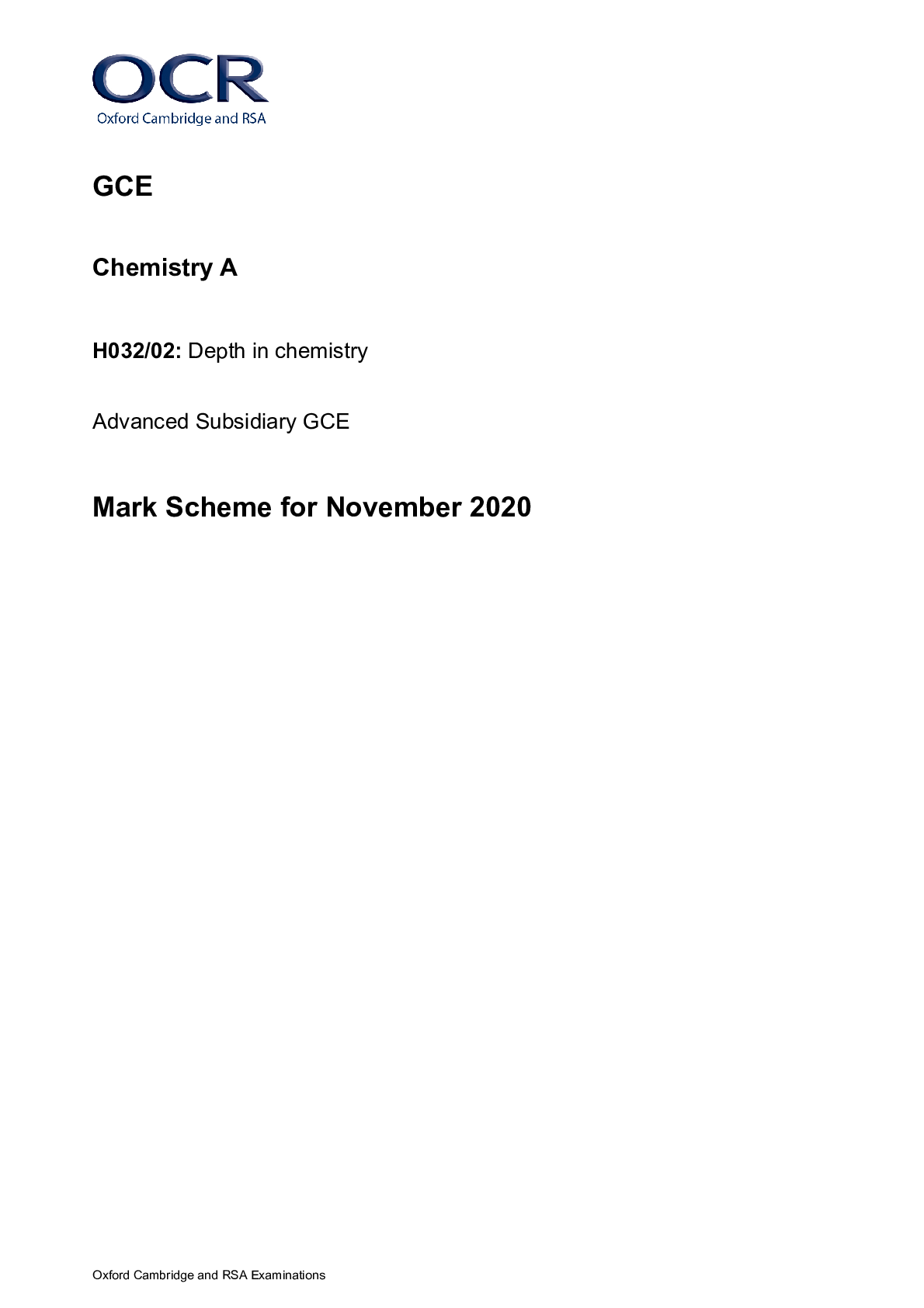

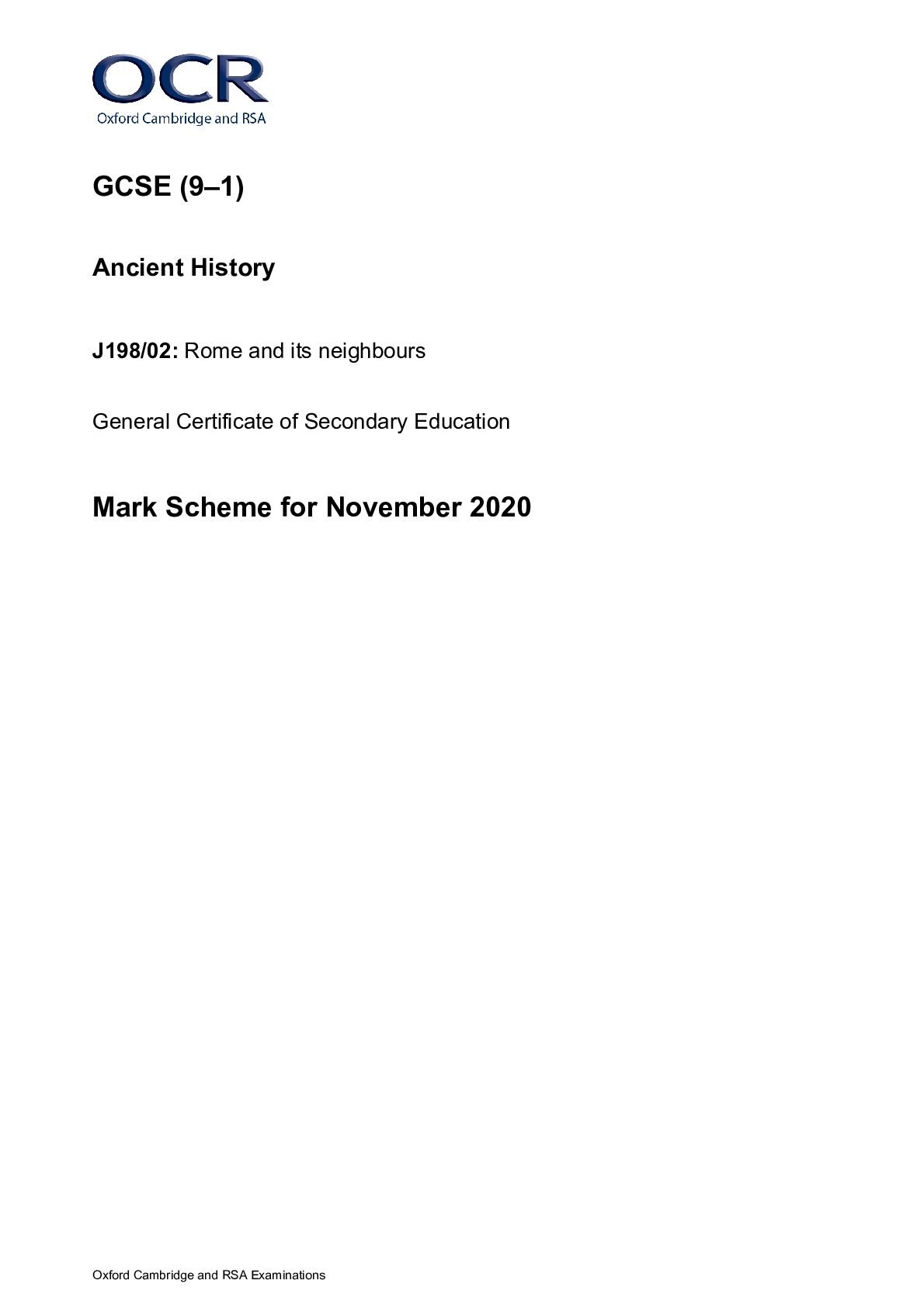




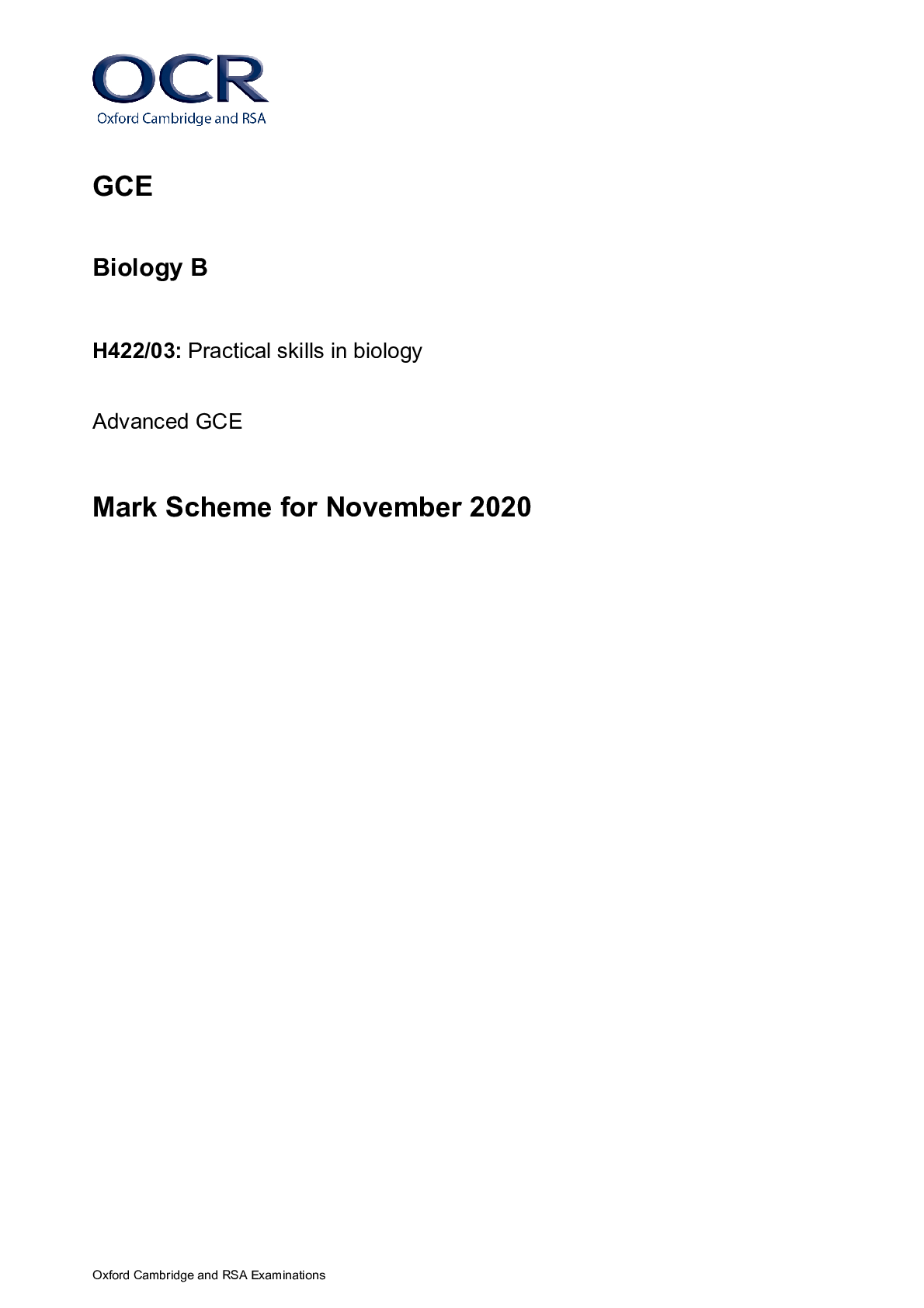
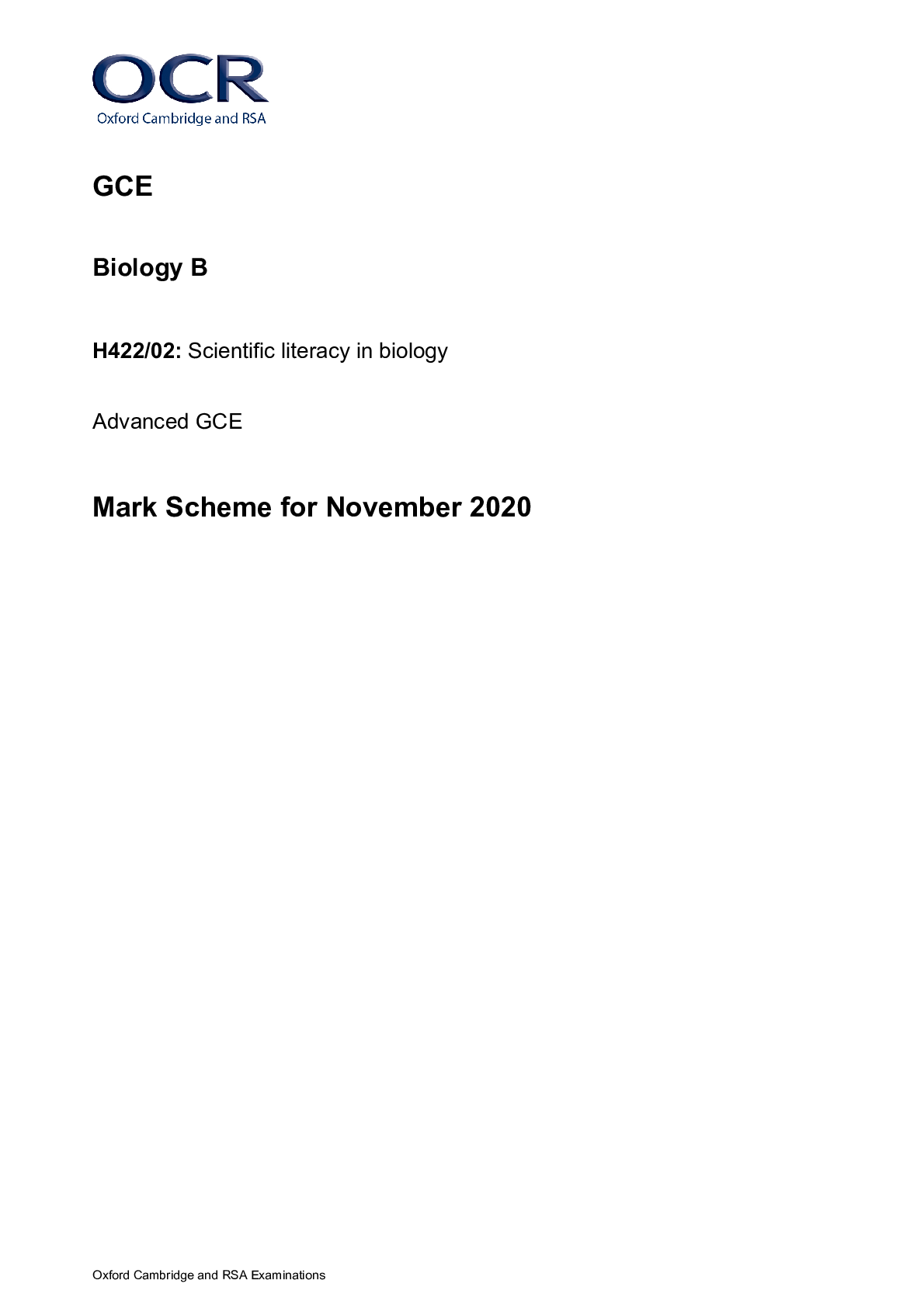
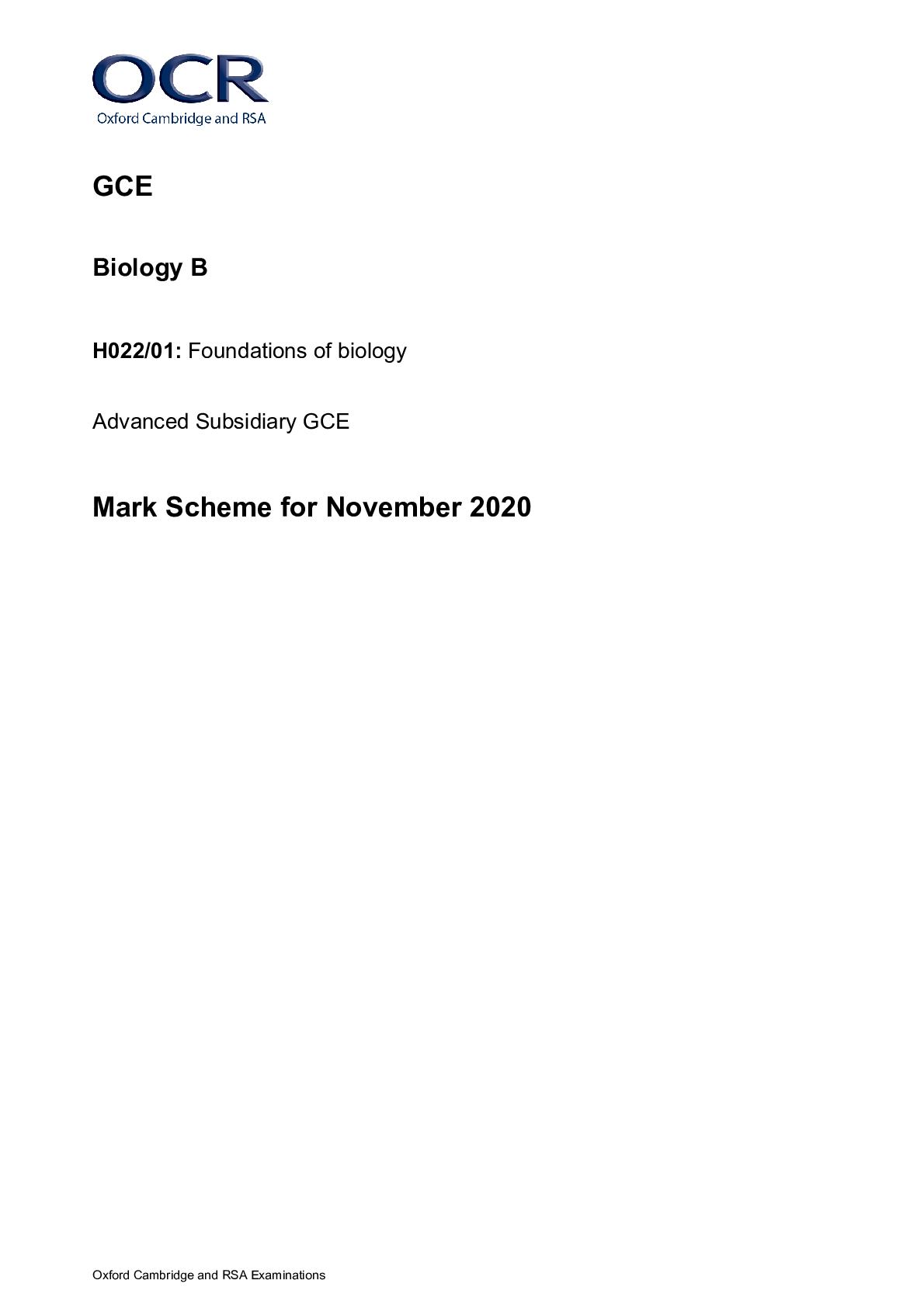



.png)
